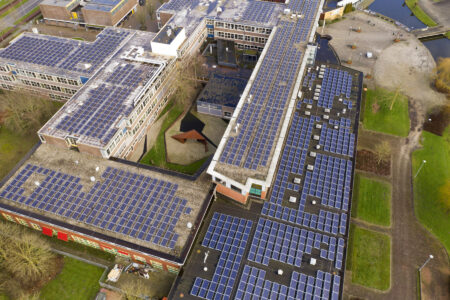Schools in the United States are huge consumers of energy; according to Energy Star, K-12 schools spend more than $6 billion annually on energy, far surpassing the amount spent on other resources, and at least 30 percent of this energy is used inefficiently or needlessly. So, schools can start to save energy in several ways, from low-cost adjustments, such as turning off lights in unused rooms, to large-scale projects, such as adding insulation. And as solar becomes a more financially viable option for powering buildings, more schools are making the move toward renewables and installing panels on their rooftops or property.
According to online solar marketplace EnergySage, schools have a unique opportunity to implement solar, because they often have the kind of spacious, level locations that are ideal for hosting solar arrays. And the benefits go beyond cutting utility costs: The Interstate Renewable Energy Council, which tracks the number of K-12 schools with solar installations and helps schools go solar, says on its website that schools with solar setups have an opportunity to educate students about clean energy, and to demonstrate a commitment to investing in their students’ — and the planet’s — health and future.
In September 2020, nonprofit Generation180 released its third edition of a study on solar in U.S. schools, titled Brighter Future, which assesses solar trends nationwide and describes how solar schools are saving millions in energy bills. Key findings include that more than 7,300, or 5.5 percent, of K-12 public and private schools use solar, a number that has increased by 81 percent since 2014, and those schools enroll more than 5.3 million students. The report provides several case studies so readers can witness the increased resilience and savings achieved by solar-powered school districts. For example, an Arkansas school district used its annual energy savings of nearly $100,000 to increase its teachers’ salaries and fill budget gaps. The report also specifies that third-party ownership has made financing possible for 79 percent of schools with solar, meaning a majority of those schools haven’t had to make a massive upfront investment to start reaping the rewards of solar energy.
The Protection of Personhood

The Yurok people have lived along the Klamath River, which flows from the Cascades in Oregon southwest through Northern California, for thousands of years, stewarding the region and river from which they — and others — draw sustenance. But as development and pollution continue to diminish the number of fish in the river and reduce the quantity and quality of its waters, the Yurok Tribe is codifying the tribe’s longstanding care by granting the Rights of Personhood to the Klamath, the first river in North America to have such rights declared.
The Yurok Tribal Council’s May 2019 resolution means the river has the same legal rights as a human under tribal law. This ordinance allows people to bring lawsuits on behalf of the river when an entity is inflicting harm in violation of its rights. According to the resolution, the tribe’s intention is to provide a legal basis for safeguarding the river and its ecosystem, especially in the face of water diversion, industrial contaminants, and climate change impacts, among other threats. In a testimony delivered to the U.S. House of Representatives in October 2019, Yurok Tribe Vice Chairman Frankie Myers said this legal framework could forge a path toward a more holistic view of the rights of nature in other communities and courts, and that any money awarded by the Yurok courts will fund cleanup and restoration projects to remedy the litigated harms.
The Yurok Tribe’s resolution draws on the United Nations Declaration on the Rights of Indigenous Peoples, and echoes the efforts of other Indigenous tribes, including the White Earth Band of Ojibwe, which adopted the Rights of Manoomin, or wild rice, in December 2018.
Protesters Defend Old-Growth Forests

A grassroots group called the Rainforest Flying Squad claims only 2.7 percent of British Columbia’s original productive old-growth forests are still standing — and, since late 2020, the group has been taking nonviolent direct action to protect what remains from logging. Driven to civil disobedience by the climate and biodiversity crisis, the activists have blockaded roads on Vancouver Island near the Fairy Creek watershed, to prevent access to the unprotected ancient forest that’s home to rare species and towering trees, some of which are thousands of years old.
The forests around Fairy Creek are in the territories of several First Nations who partnered with forestry company Teal-Jones Group to log portions of the forest, including the Pacheedaht, and Pacheedaht First Nation chiefs have been critical of the protesters’ unsolicited presence. However, the protesters have remained, citing Pacheedaht elder Bill Jones’ invitation to stay on his traditional territory, and to “remember that there are many voices within our communities. There are many different priorities and many different paths to take.”
Teal-Jones was granted an injunction against the protesters’ interference in April 2021, which was enforced by the Royal Canadian Mounted Police, who arrested approximately 1,000 people over the course of several months. Then, in late September 2021, the Supreme Court of British Columbia denied Teal-Jones an extension of this injunction, citing “serious and substantial infringement of civil liberties” by police. At the time of this writing, the protesters have maintained their blockades, while Teal-Jones has appealed the court’s decision, and has been granted an interim injunction by the B.C. Court of Appeal while the Supreme Court appeal is pending.
‘Doubly Green’ Fuel

Untapped biowaste from food scraps and manure could be transformed into $10 billion worth of renewable energy for vehicles annually, according to researcher Fateme Rezaei at the Missouri University of Science and Technology.
In a news article released earlier this year, Missouri S&T says the energy-generating process the researchers are proposing would involve capturing renewable natural gas (RNG) from biowaste, and renewable hydrogen (RH2) from the extra electricity produced by solar or wind energy. This technique has been dubbed “doubly green” because it would rely on byproducts from already “green” technologies.
But because of the prohibitive cost of processing biogas into viable vehicle fuel, this renewable resource remains mostly idle, and some areas lack the infrastructure to transport it. To overcome these obstacles without requiring the buildout of brand-new pipelines, Rezaei, an associate professor of chemical and biochemical engineering, is testing technology that would enable low-pressure storage and separation of the gases in a fuel tank. The tank would also filter and sequester carbon so it could be returned to the fueling station. With this tank, drivers could choose to run a natural gas engine on a blend of gases generated by biowaste — an option that might benefit folks in places where biowaste is abundant.
Farmers Market Safety Course
PennState Extension offers a range of educational opportunities, from articles and guides to webinars and workshops, and included on this roster is a course about farmers market food safety. Because selling at farmers markets is a popular and profitable endeavor, this course was created to teach vendors and producers about food safety and sanitation, so they can avoid spreading foodborne illnesses to their customers. Among other topics, the course covers sourcing and purchasing ingredients, food handling and preparation, selling food products, and record-keeping, and it provides a checklist for vendors to use in evaluating the safety of their setup. This beginner-intermediate course is approximately $40 for about four hours’ worth of material that’s accessible for a year after it’s purchased, and it generates a certificate upon completion.
Local Motives
To film the web series “Local Motives,” lifelong friends Nate Murray and Cody Pfister traveled in a van to every state in the continental U.S. to record their conversations with people about climate change. Through the series, the duo tells an overarching story about the relatability and relevance of climate change in the U.S., as seen “through the eyes of everyday people” — instead of centering data and rhetoric. Included in the series is a video captured in South Carolina on the history and cultural significance of sweetgrass basket weaving; a conversation with a Texas creamery about the challenges of increasingly extreme heat; and a look inside the nation’s largest compost operation to run entirely on renewable resources, located in Brooklyn, New York.
Ayrshire Cattle Graduate

The Livestock Conservancy (TLC) works to preserve heritage livestock breeds, and it keeps a Conservation Priority List for breeds that are especially endangered. Sometimes, the extra attention given to conserving listed breeds pays off, and a formerly endangered breed is able to graduate from the list. In 2021, Ayrshire cattle joined this class of graduates. Though the Conservancy’s work to preserve Ayrshires continues, the breed’s numbers are considered relatively stable globally. TLC states this hardy breed is adapted to cold climates and rugged environments, and can produce a considerable amount of milk on forage, making it particularly suitable for low-input, grass-based dairying operations.
TLC claims it’s never lost a listed breed to extinction.




